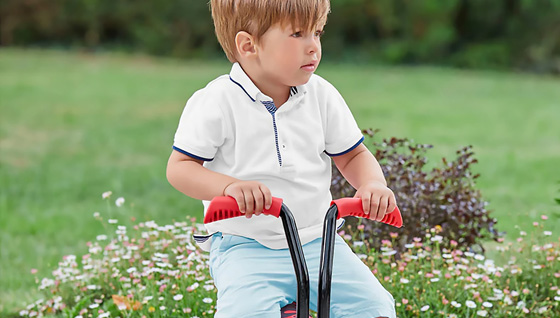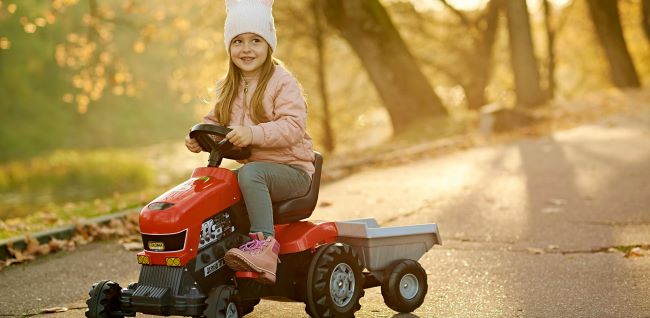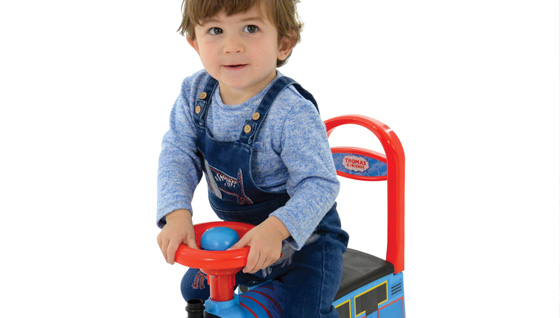The Parents’ Guide to Ride-On Toys: What You Need to Know
8 min read
Last Modified 26 June 2025 First Added 17 June 2025

Ride-on toys are so much fun for young children! Whether they’re whizzing around the garden or cruising through the living room, they promote physical development and active, exploratory play. From balance and coordination to independence and confidence, ride-on toys are a great addition to your child’s toy collection.
There are many ride-on toys to choose from, including tricycles, mini-cars, tractors, and trains, so it can be confusing for parents. This guide will help you understand the benefits them, provide information about the different types available, and answer many other important questions to help you learn which ride-on toy is right for your child.

Ride-on toys are miniature versions of larger vehicles designed for children to drive safely during playtime. There is a wide selection of ride-on toys to accommodate different ages and skill sets. They are versatile, can be used indoors or outdoors, and provide children with an excellent opportunity to perform imaginative play.
Ride-on toys can help with your child’s development in many ways. They can improve their motor skills by developing their coordination, strength and spatial awareness. Playing with them can develop problem-solving abilities as they navigate their toys around obstacles and different environments. As they improve in their coordination and develop their skills, it can also help boost their confidence and make them more assured when playing in their surroundings or with other kids.
It depends on your child’s developmental stage. Children as young as 12 months old can play with simple, push-powered ride-ons. However, some children may not want to play with ride-on toys until they are older. There is no specific age at which children begin playing with ride-on toys. The best course of action is to evaluate their developmental stage and then choose appropriate toys based on this.
The best ride-on toys for kids depend on their own interests and their developmental stage. For example, if your child enjoys playing with trains, they may want a train ride-on that they will love using at playtime! However, there are different types of ride-on toys to consider, such as:
Whether your child is a toddler, preschooler or an older child wanting more speed, our range of ride-on toys has something for every adventurous child!
The best ride-on toys for toddlers are push ride-alongs. As the parent controls the vehicle, they are a great option for family playtime and can help them develop essential motor skills that can improve their coordination and spatial awareness. They can then develop to using a ride-on where they can push and steer themselves, increasing their feeling of independence and further progressing their development.

The best ride-on toys for kids aged 3 and up tend to involve more interactive play. This can often come in the form of pedal-powered ride-ons. Using cars, tractors, and trucks can engage them in more interactive, imaginative play and further improve their developmental skills.
By the time your child is aged 6 and up, they’ll want toys that put the pedal to the metal! Electric ride-on toys come in 6v, 12v and even 24v options. They can give your child more independence and another important outlet for imaginative play as they spend more time outdoors.
Teaching your child how to play safely with electric ride-on toys is crucial. Make them aware of how to keep themselves safe by ensuring they only play with them in comfortable surroundings. They should always be supervised, wear a seat belt when available, and always drive safely on the correct path.
In terms of ride-on toys, in general, many safety considerations have been made, such as:
These are only some of the safety features included. To know more about the safety features of specific ride-on toys, please refer to the relevant product features.

If you choose an age-appropriate model, ride-on toys are safe for babies and toddlers. Just ensure they are supervised during playtime. Backrests and safety rails offer extra support to your child, helping them feel comfortable using the ride-on. Large, non-slip wheels made of rubber or durable plastic provide the vehicle with more support, particularly indoors.
Many ride-on toys can be used indoors and outdoors, so the difference between them usually comes down to their size, design and durability. Indoor ride-on toys are lightweight and compact and can be used in small, controlled spaces like a hallway or living room. They are more appropriate for children aged 12 to 36 months. Outdoor ride-on toys have larger wheels and are made from weather-resistant materials to match the environment. They also provide children with higher speed options, such as electric ride-ons.
Storing and maintaining ride-on toys can help keep them in a safe, durable condition, ensuring your kid can get the most out of their toy. We recommend regular wipe downs with a damp cloth and soap for the plastic and metal parts of ride-on toys. You can use disinfectant wipes for areas like handles and seats. For wheels, we recommend that grass and dirt be regularly removed from wheel treads to keep the toy and the environment around it as clean as possible. For electric ride-ons, we recommend that the battery and motor areas avoid contact with water.
We recommend storing ride-on toys in a sheltered, dry place that is preferably indoors (such as a garage or basement). We also recommend quickly cleaning the toy before putting it away to prevent mould or corrosion. To maintain push and pedal ride-ons, regularly tighten screws and bolts and check the condition of wheels to ensure they haven’t cracked or aren’t wobbling. For electric ride-ons, it’s important not to overcharge the battery and to remove the battery if the ride-on is being stored without use for a few weeks.
The best ride-on toys for your child ultimately depend on their developmental stage, interests, and how they want to express themselves during playtime. More active kids may be ready for electric ride-on toys by age 5 or 6, but others may not want to make that leap until they are older. The most important thing is assessing your child’s needs and wants and determining what is best for them. Finding the right ride-on toy for them will give them hours and hours of fun as they improve their development and explore the endless possibilities that imaginative play can provide.
Find more toy inspiration in our outdoor toys range.
Read our disclaimers.